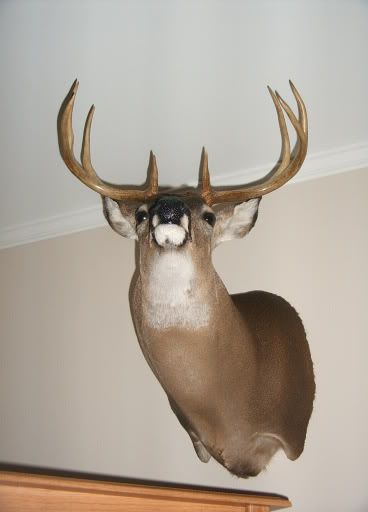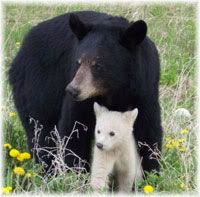



 The Accurate Reloading Forums
The Accurate Reloading Forums  THE ACCURATE RELOADING.COM FORUMS
THE ACCURATE RELOADING.COM FORUMS  Hunting
Hunting  American Big Game Hunting
American Big Game Hunting  Late Born Fawn.....
Late Born Fawn.....Go  | New  | Find  | Notify  | Tools  | Reply  |  |
one of us |
Many biologist say whitetails do not bred past the post rut in January in our Southern States. How would they explain the teeny tiny fawn I saw yesterday evening? The little guy couldn't have weighed 20lbs and totally covered in spots. Had two other yearlings com by that were 3x the size of that little fawn. Strange. I've seen spotted fawns in Oct, but never that small. I'm guessing she had to have been bred in late spring? Reloader | ||
|
| One of Us |
any biologist worth his salt will tell you that there are no absolutes. Under the right conditions nature does some surprising things occasionally. | |||
|
| One of Us |
I was in Yellowstone one year at the end of june and saw an elk calf that was about an hour old and I wondered if it really had a chance to make through that coming winter. Rad NRA Benefactor Member | |||
|
| One of Us |
I have read that in Florida a deer may come in season at any time of the year. And it is an oddity here but this year I am seeing fawns that still have spots in early Oct. | |||
|
| one of us |
Yeah, lots of late fawns this year everywhere I've been -- even in southern Colorado where I saw mule deer fawns that appeared to be no more than six weeks old in September. It makes sense that does which were late fawns themselves may not reach sexual maturity until late in the breeding season. I don't doubt that a signficant number of does are bred as late as March here in Central Texas. All of which tells you that hunting by attempting to time the "rut" is a difficult, if not impossible, strategy. There are clearly peaks in breeding activity, but so long as there is a doe in heat, there will be breeding going on. The "rut" seems increasingly to be spread over four or more months for southern whitetails. This would actually seem to be a positive survival adaptation, as winters here are not the killers that they are in more northerly climates, and factors such as unpredictable seasonal drought and hunting season itself make a spread out breeding season more successful for the species than a concentrated one. | |||
|
| One of Us |
We caught two speckled fawns coming into a pile or corn in December 2004. They both made it to spring luckily. Joe "I can't be over gunned because the animal can't be over dead"-Elmer Keith | |||
|
one of us |
in 1989 a friend of mine and I filmed a buck that dropped his antlers mount a doe and breed her 3-4 times in a cut field the first week of March. Many things have to be considered. Take an old Doe, for instance, that comes into heat on Halloween day. She'll have early fawns next spring. If she happens to birth Doe fawns, they may likely be mature enough to breed the next deer season. I've read that a Doe only need be 6-7 mos old before she reaches her first heat. Many of the tiny fawns seen this late in the season are born to fawns from last spring that came into heat late (December-February). Ted Kennedy's car has killed more people than my guns | |||
|
| One of Us |
I came up with a theory on this topic a couple of years back. While I have no real concrete evidence to prove my theory, there appears to be a growing amount of circumstantial evidence that points toward the possibility my theory is on track to becoming reality. I believe that due to factors such as size of the population, supplemental feeding, changes in our climate for whatever reason, and possibly a couple more, that white tails are under going an evolutionary change right before our eyes. I think that with the factors I listed and possibly a few more that I have not thought about, white tails are evolving to be more like axis deer, in that they will be able to breed year round and have fawns at all times of the year. I feel that for whatever reason, the old evolutionary model of having the young at the most advantageous time of the year for their survival, early to mid spring, that model is no longer necessary and there is no advantage for the species as a whole to have all the young born during a certain time frame. JAT. Even the rocks don't last forever. | |||
|
| one of us |
Actually, it IS advantageous for fawns to be born during the cooler part of the year when you are talking about areas in which fire ants abound. In many areas, fire ants are a bigger problem than predators when it comes to fawn survival rates. Bobby Μολὼν λαβέ The most important thing in life is not what we do but how and why we do it. - Nana Mouskouri | |||
|
| One of Us |
Under normal circumstances I would agree, but with the way our climate has been going, we are not really having that cooler weather the way it was 50 or 100 years ago, let alone a couple of million years ago when white tails evolved. Just a point of curiosity here, but how many days of freezing weather did you have down at Shiner this past winter? I don't figure too many, because we didn't have very many up here in the DFW MetroMess. Over the past 5 years or so, we have not been having those long cold spells that did have an effect on the insect populations. It has been a few days of cold with warmer spells in between. Also, when the basic biology scheme was laid down for white tails, fire ants were not a problem. As I say, this is just a theory that I have come up with. Even the rocks don't last forever. | |||
|
| one of us |
With the fire ant, though, temperatures below 68 degress only allow them minimal activity. A freeze isn't necessary to slow them down. Regardless, I truly despise those things... Bobby Μολὼν λαβέ The most important thing in life is not what we do but how and why we do it. - Nana Mouskouri | |||
|
| One of Us |
I'm seeing the same thing here in upstate N.Y. I live about 10mi east of lake ontario in the snowbelt,sometimes we get 4ft in one night, and I've seen it start snowing and not stop for 4 or 5 days and i seen 2 fawns the other day and they were real small. | |||
|
| One of Us |
Could it be the simple fact that there are not enough bucks to cover the available does on their first or second or even third cycle. I don't remember the numbers but the does are only in for a few days then out for about 21 (I think) then back in for a few and so forth. | |||
|
| One of Us |
i skinned out a doe yesterday morning that was still full of milk. | |||
|
| One of Us |
I hate fire ants also, but TP&W will set and tell you that fireants cause minimal damage to wildlife including bobwhite quail. Even the rocks don't last forever. | |||
|
| one of us |
In NY fawns have in fact been born in every month of the year ! Those born off season of course have problems surviving. | |||
|
| one of us |
Finally, after many years, at least some of the TPWD biologists are admitting that fire ants are indeed causing declines in ground-nesting birds and impacting other wildlife as well. FOr years, they told me, too, that fire ants were a non-factor but could not answer when I asked about the nests that were beginning to hatch that were overtaken by ants or the fawns that hit the ground and were literally bitten to death by ants that got into their mouths, onto their eyes, etc. Some would have so many bites their tongues/throats would be so swollen that they could not have been able to take a breath. Bobby Μολὼν λαβέ The most important thing in life is not what we do but how and why we do it. - Nana Mouskouri | |||
|
one of us |
I also feel that's part of the problem. Too many does on most of the land around here. Many hunters will not shoot a doe. Reloader | |||
|
| one of us |
Here's two fawns I caught on a trailcam on September 14th on my property in upstate NY, near Utica. Don't see them this small this late very often around here, especially the one in the back, which is smaller and more spotted than the one in the front.  . "Listen more than you speak, and you will hear more stupid things than you say." | |||
|
one of us |
I saw another while squirrel hunting and scouting this past weekend. A very small one covered in spots, much smaller than the two in Erict's photo. Cute little boogers. Reloader | |||
|
| Powered by Social Strata |
| Please Wait. Your request is being processed... |
|

Visit our on-line store for AR Memorabilia

